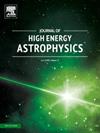Measuring the intensity of the interstellar radiation field with ultra-high energy γ ray spectra
IF 10.5
4区 物理与天体物理
Q1 ASTRONOMY & ASTROPHYSICS
引用次数: 0
Abstract
Our understanding of the intensity distribution of the interstellar radiation background is based on the observational data from IRAS, COBE-FIRAS and Planck. The intensity of this radiation field increases rapidly towards the Galactic plane and is the highest near the Galactic centre due to the high density of stars and dust. However, a precise determination of the variations of this radiation field with spatial and angular coordinates is not feasible observationally. We explore how future studies of gamma-ray spectra from numerous ultra-high-energy gamma-ray sources can indirectly probe variations in the interstellar radiation field's intensity across different distances from the Galactic centre and across Galactic latitudes and longitudes. This study is crucial for making self-consistent predictions of high energy gamma-ray fluxes from Galactic sources detected by observatories like LHAASO, Tibet ASγ and the next-generation gamma-ray telescopes.
用超高能γ射线能谱测量星际辐射场强度
我们对星际辐射背景强度分布的理解是基于IRAS、COBE-FIRAS和普朗克的观测数据。这个辐射场的强度向银道面迅速增加,在靠近银道中心的地方由于恒星和尘埃的高密度而达到最高。然而,用空间和角坐标精确地确定辐射场的变化在观测上是不可行的。我们探讨了未来对来自众多超高能量伽马射线源的伽马射线谱的研究如何间接探测星际辐射场强度在距离银河系中心不同距离以及跨越银河系纬度和经度的变化。这项研究对于自洽地预测由LHAASO、西藏ASγ和下一代伽玛射线望远镜等天文台探测到的银河系源的高能伽玛射线通量至关重要。
本文章由计算机程序翻译,如有差异,请以英文原文为准。
求助全文
约1分钟内获得全文
求助全文
来源期刊

Journal of High Energy Astrophysics
Earth and Planetary Sciences-Space and Planetary Science
CiteScore
9.70
自引率
5.30%
发文量
38
审稿时长
65 days
期刊介绍:
The journal welcomes manuscripts on theoretical models, simulations, and observations of highly energetic astrophysical objects both in our Galaxy and beyond. Among those, black holes at all scales, neutron stars, pulsars and their nebula, binaries, novae and supernovae, their remnants, active galaxies, and clusters are just a few examples. The journal will consider research across the whole electromagnetic spectrum, as well as research using various messengers, such as gravitational waves or neutrinos. Effects of high-energy phenomena on cosmology and star-formation, results from dedicated surveys expanding the knowledge of extreme environments, and astrophysical implications of dark matter are also welcomed topics.
 求助内容:
求助内容: 应助结果提醒方式:
应助结果提醒方式:


